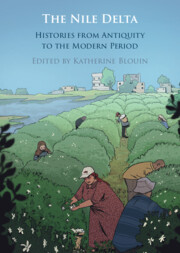Book contents
- The Nile Delta
- The Nile Delta
- Copyright page
- For Mona Abaza
- Contents
- Figures
- Maps
- Tables
- Contributors
- Acknowledgements
- Abbreviations
- 1 Introduction
- 2 Call Me by My Names
- 3 The Nile Delta before the Pharaohs
- 4 The Khetem-Border-Posts in the Delta during the New Kingdom
- 5 New Land amongst New Rivers?
- 6 The Mareotis Area
- 7 From Memphis to Alexandria
- 8 Growing with the Empire? From Village to Town
- 9 Mapping the Cult of Christian Saints in the Nile Delta from the Fifth to the Ninth Century CE
- 10 Alexandria
- 11 Imperial Power, Tribal Settlement and Fiscal Revolts in the Early Islamic Delta (Seventh to Ninth Century CE)
- 12 The Nile as Nexus
- 13 Water and Prices
- 14 Water Development in the Medieval Western Delta
- 15 The Nile Delta in European Cartography, 1200–1800
- 16 Just Passing Through?
- 17 Reclaiming the Archive
- 18 Short Commentary on Accounting Documents from a Vanishing Cotton Estate (ʿIzba) in the Nile Delta
- Index
- References
3 - The Nile Delta before the Pharaohs
Published online by Cambridge University Press: 15 February 2024
- The Nile Delta
- The Nile Delta
- Copyright page
- For Mona Abaza
- Contents
- Figures
- Maps
- Tables
- Contributors
- Acknowledgements
- Abbreviations
- 1 Introduction
- 2 Call Me by My Names
- 3 The Nile Delta before the Pharaohs
- 4 The Khetem-Border-Posts in the Delta during the New Kingdom
- 5 New Land amongst New Rivers?
- 6 The Mareotis Area
- 7 From Memphis to Alexandria
- 8 Growing with the Empire? From Village to Town
- 9 Mapping the Cult of Christian Saints in the Nile Delta from the Fifth to the Ninth Century CE
- 10 Alexandria
- 11 Imperial Power, Tribal Settlement and Fiscal Revolts in the Early Islamic Delta (Seventh to Ninth Century CE)
- 12 The Nile as Nexus
- 13 Water and Prices
- 14 Water Development in the Medieval Western Delta
- 15 The Nile Delta in European Cartography, 1200–1800
- 16 Just Passing Through?
- 17 Reclaiming the Archive
- 18 Short Commentary on Accounting Documents from a Vanishing Cotton Estate (ʿIzba) in the Nile Delta
- Index
- References
Summary
From the 5th millennium BCE onward, the Nile Delta constituted a distinct cultural entity that pursued its own economic and social development, until the advent of the 1st Dynasty and the political unification of Egypt. Despite this, the role Lower Egypt played in the formative process of the Pharaonic state has long been overshadowed by a greater focus on Upper Egypt and a narrative of state formation dominated by Upper Egyptian culture. Now, thanks to increasing archaeological projects in the Nile Delta, we can better assess the economic and social changes that occurred in the Delta throughout the 5th and 4th millennia BCE, as well as their interactions with neighbouring cultures. Revised interpretations of the anthropisation of the Delta and its role in the emergence of Pharaonic civilisation are offered in a way that considers local communities themselves, no longer distorted by Upper Egyptian remains, later royal propaganda and historical models from the last century. In this chapter, we will try to follow the path of Lower Egyptian populations as they first adopted agriculture and settled in permanent villages, then developed into a regional culture at the crossroads of southwestern Asia and northeastern Africa, before finally becoming a hierarchical society.
- Type
- Chapter
- Information
- The Nile DeltaHistories from Antiquity to the Modern Period, pp. 105 - 157Publisher: Cambridge University PressPrint publication year: 2024



